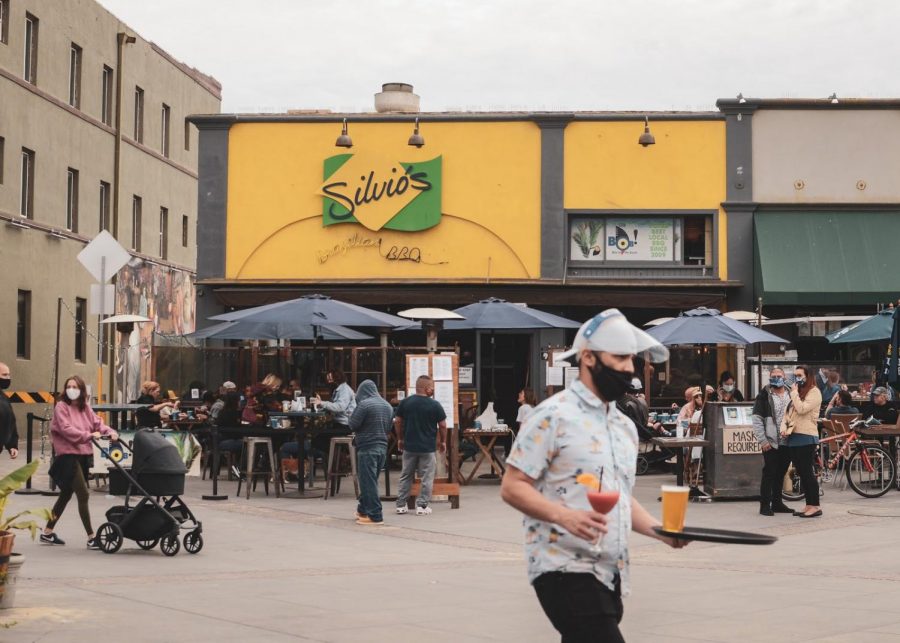A Glimmer of Hope: Outdoor Dining Resumes
Art/Photo by Sullivan Kolakowski
For the past 6 months, restaurants have faced strict COVID guidelines. Last week was LA County’s first time in a long time where restaurants were once again allowed to serve guests outdoors. This is a huge victory for restaurants that were struggling to stay open during this unknown time. Doug Howarth, the owner of Silvio’s, expressed that he’s glad to be open for business and safety is still the number one priority, “You’re nervous for your own health, as well as your employees’ health. You’re worried about your income and business.”
February 4, 2021
The pandemic was a sign of the worst for the food industry. Many businesses were hit with financial loss, leaving them unable to recover and forced to shut down. By March, it was estimated that almost half of the industry’s 15 million workers were laid off. But on January 25th, Gov. Gavin Newsom effectively lifted December’s Regional Stay-At-Home Order.
Considering the recent discovery of a COVID-19 variant in California and rising cases, this announcement may seem surprising. But Newsom said four-week projections by the state display a notable rise in ICU capacity. Southern California is projected to have 33.3% capacity in the upcoming month.
This garnered a few notable changes. California would be returning to the color code tier system based on the condition of each county. 54 of California’s 58 counties will be returning to the most restrictive purple tier. While there may be many modifications, this generally allows malls, retail stores, personal care services, movie theaters, and places of worship to reopen. This also means outdoor dining can resume, a significant and surprising change for many restaurants.
The stay-at-home order affected many local businesses immensely. Student Suzan Hui (12) has been working at her parents’ shop Best World Donuts. She described how they were forced to adapt: “Before the pandemic, a lot of our customers usually stopped by our shop before and or after work to get a snack and coffee.” But once non-essential workers were forced to stay home, she noticed a large decline in business. Hui also found difficulty in limiting store capacity and staying socially distant due to the already small size of the shop. But they are expecting to see more familiar faces now that the order is lifted. “It might start off slow,” Hui said, “but any little bit counts for a small business.”
Silvio’s Brazilian BBQ owner Doug Howarth explained that during the beginning of lockdown, instead of indoor dining they would often have customers seated at the tables along the promenade overlooking Hermosa Beach. But this was shut down a few weeks ago, forcing Silvio’s into takeout and delivery only. In the long term, both of these options were not sustainable. While Howarth isn’t planning on opening for all available hours, being allowed to offer an outdoor dining experience will greatly benefit their business.
Although outdoor dining is in the all-clear, this doesn’t mean it will be all easy sailing. There are numerous steps all restaurants alike may go through when opening including inventory stocking, menu planning, making the restaurant presentable to customers after months of inactivity. One of the most prominent obstacles is finding new employees. When the mandate was lifted, Howarth realized that he would be understaffed when Silvio’s eventually opens. “A lot of these people can’t afford to just sit at their house and wait to come back to work,” he explained. Not only will he have to find people, but the cost of training and finding each workers’ availability might be a challenge. As Howarth described, “It’s not just like flicking the switch in your bedroom.” Thankfully, the rain from the weekend offered a slow day for Howarth and his team to ease into their routine and ensure that they will be prepared for the busier weeks to come.
Howarth also expressed his frustration with how the governor is issuing these mandates. “When they first allowed people to reopen in mid-April… you just heard via a news conference in the middle of the morning on Friday, ‘Okay, everyone can open today,’” he described. “That was it.” He argues that not giving any instruction on how to reopen, what information to relay to staff, and the supplies needed for safe service could have put many businesses at risk. Altogether, Howarth says these changes have taken its mental and physical toll.
But nevertheless, restaurants will be utilizing these opportunities they’ve been given and keep fighting to stay afloat.














